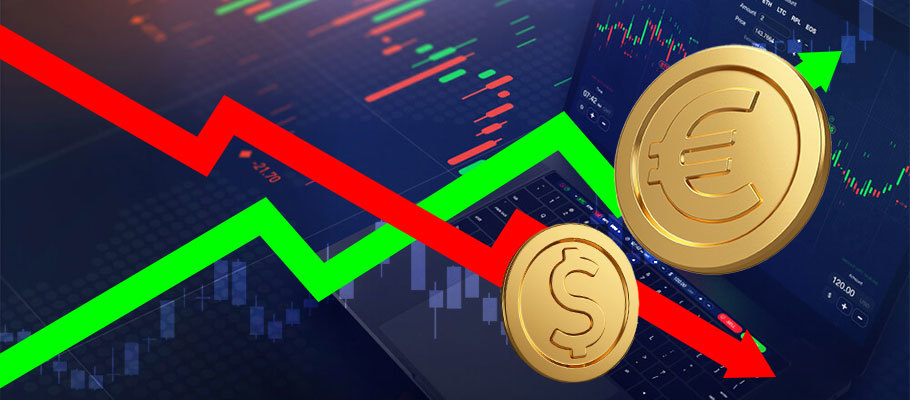
Published: September 6th, 2021
The euro-to-dollar rate is kicking off the week with indications that a trend reversal may be brewing, fuelled by further dollar declines and hints from the European Central Bank (ECB) about coming policy changes that could give the euro a boost.
The single currency rose above the critical level of 1.1871 ahead of the weekend when the greenback experienced widespread pressure from forex markets, apparently eager to start cashing out of previously rising bets on USD.
In a Friday note to investors, Commerzbank’s currency analysis unit said that EUR/USD spent the early part of last week pushing a short term downtrend before breaking higher on Friday.
‘This has completed a pattern of reversal, and we’re now looking for gains that could approach the 1.1908 high seen in July.’
Commerzbank says it’s now looking for the euro to lift upwards as far as 1.2003, although it will need to push past a barrage of technical resistances to do so.
The euro and other majors received a fillip last week when Federal Reserve (Fed) Chairman Jerome Powell told the US Jackson Hole Symposium in his opening address that the central bank was set to disappoint traders who had a bullish view on the greenback.
He told attendees that in order for the Fed to move forward with the anticipated (but not confirmed) tapering of its quantitative easing programme this calendar year, America’s economy would have to pass ‘substantially more stringent tests’ before interest rates can go up.
Economists at ING told Reuters that the comment had raised market expectations for a first Fed tightening later in 2022 ‘and weighed on the dollar through much of last week’.
That could mean more dollar unravelling after a months-long rally that left no major currency untouched. Despite attention turning to the euro this week, ING says that for the single currency to sustain an advance beyond the 1.19 level or beyond, there will need to be an economic catalyst from within the eurozone. USD declines alone won’t lift the pair to those highs.
The European Central Bank (ECB) is signalling that events in the fourth quarter of 2021 could be decisive in terms of its interest rate decisions.
Peter Lane, a senior ECB economist, told Bloomberg last week that the bank will assess the situation at its September meeting before deciding what ‘calibration’ will be required in the Q4, ‘taking into consideration market interest rate movements and the outlook for inflation.’
‘We’ll have to review interest rate movements at the subsequent meetings in October and November as well,’ he added. ‘The tolerance for financing levels and related conditions depends on the inflation dynamic and how robust it is.
While the ECB’s post-meeting pronouncements will be watched closely, this week’s dollar news will likely be dominated by ups and downs in response to American economic numbers. However, the euro could find itself basking in homegrown support in September if ECB economist Lane’s other comments signalled a favourable policy change.
He also told Bloomberg that, given Europe’s buzzing economic recovery and the significant stimulus already given to eurozone economies via the ECB’s Pandemic Emergency Purchase Programme QE programme, the declines in government bond yields seen recently could point to the need for an earlier reduction the pace of government bond-buying.
Addressing the comments in a market analysis last Thursday, Nordea Markets’ FX Strategy Unit says it’s important to remember that the ECB is unlikely to ever explicitly call such a move tapering. ‘They prefer the language of ‘technical adjustments to the program’, which they see as less incendiary.’
The euro-dollar rate rallied briefly on Lane’s remarks last week, but the majority of gains for the week overall were seen to off the back of declines in the greenback. With eurozone inflation figures now out, the dollar could be back in the driver’s seat in the early part of the week.
August’s inflation figures rose to three per cent, and economists are now suggesting that a continuation above the ECB’s target two per cent threshold is possible. However, it isn’t clear if that would impact the euro since the bank has been vocal in its doubts about whether current economic growth in the eurozone can be sustained over the longer term.
‘The debate over QE tapering is now going to be shaped by how much of Powell’s “further substantial progress” toward Fed objectives is achieved in Q4.’
Last week was littered with American economic data, and markets will be signalling enthusiasm or disappointment this week. Negative sentiment could potentially support the euro.
Markets are now sifting through the numbers for cumulative evidence that the US economy has recovered from the COVID-19 effect. Disappointing nonfarm payrolls numbers showed that new hiring fell well short of expectations in August. Economists were looking for roughly 730,000 new jobs, but only 235,00 were reported. In July, more than 940,000 jobs were added.
Investors will now be on the lookout for clues about the likely pace of growth on the fourth quarter from the Institute for Supply Management’s August PMI report for the city of Chicago, which covers business conditions in America’s third-largest urban mega-economy. They’ll also be parsing the figures from the ISM Manufacturing PMI release and the influential ISM Services PMI release numbers.
In July, each of these benchmark statistical releases pointed to an accelerating pace of growth in Q3. The question this week is whether traders will see the nonfarm payroll figures as decisive evidence of a downturn, given its influence on inflation. The pace of labour market recovery is a key determinant of Fed decisions about its QE programme and when to start slowing it down.